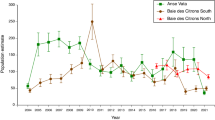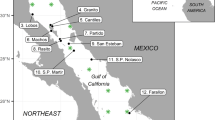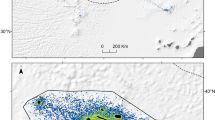Abstract
The factors affecting the population dynamics of seabirds have long intrigued biologists1,2,3,4,5. Current data suggest that density-dependent depletion of prey during the breeding season may regulate population size6,7,8,9. However, much of the evidence for this has been circumstantial, and the underlying mechanisms are unclear5,10. Here, we show that the per capita population growth rates of northern gannet Morus bassanus at colonies in Britain and Ireland have declined with increasing population size. Furthermore, direct observations reveal that the mean foraging trip duration of breeding gannets is positively correlated with colony size, both among colonies of different sizes in the same year, and within colonies as they change in size. To understand this phenomenon, we have developed a model which demonstrates that disturbance of fish alone can readily generate conditions under which gannets at larger colonies have to travel further to obtain food.
This is a preview of subscription content, access via your institution
Access options
Subscribe to this journal
Receive 51 print issues and online access
$199.00 per year
only $3.90 per issue
Buy this article
- Purchase on Springer Link
- Instant access to full article PDF
Prices may be subject to local taxes which are calculated during checkout



Similar content being viewed by others
References
Ashmole, N. P. The regulation of numbers of tropical oceanic birds. Ibis 103, 458–473 (1963).
Lack, D. Population Studies of Birds 252–270 (Oxford Univ. Press, Oxford, 1966).
Birkhead, T. R. & Furness, R. W. in Behavioural Ecology: Ecological Consequences of Adaptive Behaviour (eds Sibly, R. & Smith, R.) 145–167 (Blackwell Scientific, Oxford, 1985).
Cairns, D. K. The regulation of seabird colony size: A hinterland model. Am. Nat. 134, 141–146 (1989).
Croxall, J. P. & Rothery, P. in Bird Population Studies: Relevance to Conservation and Management (eds Perrins, C. M., Lebreron, J.-D. & Hirons, G. J. M.) 272–296 (Oxford Univ. Press, Oxford, 1991).
Furness, R. W. & Birkhead, T. R. Seabird colony distributions suggest competition for food supplies during the breeding season. Nature 311, 655–656 (1984).
Gaston, A. J., Chapdelaine, G. & Noble, D. G. The growth of Thick-billed Murre chicks at colonies in Hudson Strait: inter- and intra-colony variation. Can. J. Zool. 61, 2465–2475 (1983).
Hunt, G. L., Eppley, Z. A. & Schneider, D. C. Reproductive performance of seabirds: the importance of population and colony size. Auk 103, 306–317 (1986).
Birt, V. L., Birt, T. P., Goulet, D., Cairns, D. K. & Montevecchi, W. A. Ashmole's halo: direct evidence for prey depletion by a seabird. Mar. Ecol. Prog. Ser. 40, 205–208 (1987).
Wooler, R. D., Bradley, J. S. & Croxall, J. P. Long-term population studies of seabirds. Trends Ecol. Evol. 7, 111–114 (1992).
Nur, N. & Sydeman, W. J. Survival, breeding probability and reproductive success in relation to population dynamics of Brandt's Cormorants Phalacrocorax penicillatus. Bird Study 46 (Suppl.), 575–578 (2000).
Croxall, J. P. Seabirds: Feeding Ecology and Role in Marine Ecosystems (Cambridge Univ. Press, Cambridge, 1987).
Forbes, L. S., Jajam, M. & Kaiser, G. W. Habitat constraints and spatial bias in seabird colony distributions. Ecography 23, 575–578 (2000).
Coulson, J. C. The changing status of the Kittiwake Rissa tridactyla in the British Isles, 1969–79. Bird Study 30, 9–16 (1983).
Lloyd, C., Tasker, M. L. & Partridge, K. The Status of Seabirds in Britain and Ireland 13–24 (T & AD Poyser, London, 1991).
Furness, R., Ensor, K. & Hudson, A. The use of fishery waste by gull populations around the British Isles. Ardea 80, 105–113 (1992).
Hamer, K. C., Phillips, R. A., Wanless, S., Harris, M. P. & Wood, A. G. Foraging ranges, diets and feeding locations of gannets in the North Sea: evidence from satellite telemetry. Mar. Ecol. Prog. Ser. 200, 257–264 (2000).
Hamer, K. C., Phillips, R. A., Hill, J. K., Wanless, S. & Wood, A. G. Contrasting foraging strategies of gannets Morus bassanus at two North Atlantic colonies: prey patchiness and foraging area fidelity. Mar. Ecol. Prog. Ser. (in the press).
Nelson, J. B. The Sulidae: Gannets and Boobies (Univ. Aberdeen, Oxford, 1978).
Garthe, S., Gremillet, D. & Furness, R. W. At-sea activity and foraging efficiency in chick-rearing northern gannets Sula bassana: a case study in Shetland. Mar. Ecol. Prog. Ser. 185, 93–99 (1999).
Murray, S. & Wanless, S. The status of the Gannet in Scotland 1994–1995. Scot. Birds 19, 10–27 (1997).
Pollard, E., Lakhani, K. & Rothery, P. The detection of density-dependence from a series of annual censuses. Ecology 68, 2046–2055 (1987).
Logerwell, E. A. & Hargreaves, N. B. Seabird impacts on forage fish. Proc. Int. Symp. on the Role of Forage Fishes in Marine Ecosystems 191–196 (Alaska Sea Grant College Program Report 97-01, Univ. Alaska Fairbanks, Fairbanks, 1997).
Monaghan, P., Uttley, J. D. & Okill, D. Terns and sandeels: seabirds as indicators of change in marine fish populations. J. Fish Biol. 35 (Suppl. A), 339–340 (1989).
Potts, G. R., Coulson, J. C. & Deans, I. R. Population dynamics and breeding success of the shag, Phalacrocorax aristotelis, on the Farne Islands, Northumberland. J. Anim. Ecol. 49, 465–484 (1980).
Furness, R. W. & Tasker, M. L. Seabird consumption in sand lance MSVPA models for the North Sea, and the impact of industrial fishing on seabird populations. Proc. Int. Symp. on the Role of Forage Fishes in Marine Ecosystems 147–169 (Alaska Sea Grant College Program Report 97-01, Univ. of Alaksa Fairbanks, Fairbanks, 1997).
Fisher, J. & Vevers, H. G. The breeding distribution, history and population of the North Atlantic Gannet Sula bassana. J. Anim. Ecol. 12, 173–213 (1943).
Cramp, S., Bourne, W. R. P. & Saunders, S. The Seabirds of Britain and Ireland 238 (Collins, London, 1974).
Murray, S. & Wanless, S. The status of the Gannet in Scotland 1984–1985. Scot. Birds 14, 74–85 (1986).
Upton, A. J., Pickerell, G. & Heubeck, M. Seabird Numbers and Breeding Success in Britain and Ireland, 1999 (UK Nature Conservation, No. 24, JNCC, Peterborough, 2000).
Acknowledgements
This paper could not have been written without the long tradition of counting gannets pioneered by J. H. Gurney and continued by J. Fisher, H. G. Vevers, D. Saunders and S. Murray. We thank T. Begg, A. Bull, J. Bull, F. Daunt, C. Gray, M. Harris, C. Holt, M. Maher, L. Milne, D. de Palacio, K. Redman and C. Roger for recording changeover rates. We also thank D. Bates, P. Harvey, O. Merne and A. Walsh, the Neale family, D. Shaw, M. and L. Smyth, B. Zonfrillo, the Royal Society for the Protection of Birds and the Scottish Seabird Centre for logistical support. S. Bearhop, D. Elston and A. Stien gave statistical advice, while S. Albon, F. Daunt, M. Harris, R. Moss, J. Sherratt and K. Thompson commented on an earlier draft. This project was funded by a Natural Environment Research Council CASE Research Studentship to S.L.
Author information
Authors and Affiliations
Corresponding author
Rights and permissions
About this article
Cite this article
Lewis, S., Sherratt, T., Hamer, K. et al. Evidence of intra-specific competition for food in a pelagic seabird. Nature 412, 816–819 (2001). https://doi.org/10.1038/35090566
Received:
Accepted:
Issue Date:
DOI: https://doi.org/10.1038/35090566
This article is cited by
-
Foraging movements and important sites for conservation of the West African Crested Tern Thalasseus albididorsalis breeding in Guinea-Bissau
Marine Biology (2024)
-
Marked differences in foraging area use and susceptibility to predation between two closely-related tropical seabirds
Oecologia (2023)
-
Body size variation in a tropical seabird along a latitude-productivity gradient
Journal of Ornithology (2023)
-
Variation among species and populations in bill shape and size in three planktivorous petrels
Marine Biology (2022)
-
Territoriality constrains foraging activity and has carry-over effects on reproductive investment
Marine Biology (2022)
Comments
By submitting a comment you agree to abide by our Terms and Community Guidelines. If you find something abusive or that does not comply with our terms or guidelines please flag it as inappropriate.



